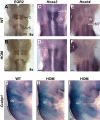Nav2 is necessary for cranial nerve development and blood pressure regulation
- PMID: 20184720
- PMCID: PMC2843687
- DOI: 10.1186/1749-8104-5-6
Nav2 is necessary for cranial nerve development and blood pressure regulation
Abstract
Background: All-trans retinoic acid (atRA) is required for nervous system development, including the developing hindbrain region. Neuron navigator 2 (Nav2) was first identified as an atRA-responsive gene in human neuroblastoma cells (retinoic acid-induced in neuroblastoma 1, Rainb1), and is required for atRA-mediated neurite outgrowth. In this paper, we explore the importance of Nav2 in nervous system development and function in vivo.
Results: Nav2 hypomorphic homozygous mutants show decreased survival starting at birth. Nav2 mutant embryos show an overall reduction in nerve fiber density, as well as specific defects in cranial nerves IX (glossopharyngeal) and X (vagus). Nav2 hypomorphic mutant adult mice also display a blunted baroreceptor response compared to wild-type controls.
Conclusions: Nav2 functions in mammalian nervous system development, and is required for normal cranial nerve development and blood pressure regulation in the adult.
Figures








Similar articles
-
Expression pattern of Nav2 in the murine CNS with development.Gene Expr Patterns. 2020 Jan;35:119099. doi: 10.1016/j.gep.2020.119099. Epub 2020 Feb 18. Gene Expr Patterns. 2020. PMID: 32081718
-
The atRA-responsive gene neuron navigator 2 functions in neurite outgrowth and axonal elongation.Dev Neurobiol. 2008 Nov;68(13):1441-53. doi: 10.1002/dneu.20670. Dev Neurobiol. 2008. PMID: 18726912 Free PMC article.
-
Nav2 hypomorphic mutant mice are ataxic and exhibit abnormalities in cerebellar development.Dev Biol. 2011 May 15;353(2):331-43. doi: 10.1016/j.ydbio.2011.03.008. Epub 2011 Mar 16. Dev Biol. 2011. PMID: 21419114 Free PMC article.
-
Role of all-trans retinoic acid in neurite outgrowth and axonal elongation.J Neurobiol. 2006 Jun;66(7):739-56. doi: 10.1002/neu.20241. J Neurobiol. 2006. PMID: 16688769 Review.
-
Retinoids: from hindbrain patterning to Parkinson disease.Trends Genet. 1997 Sep;13(9):343-5. doi: 10.1016/s0168-9525(97)01218-3. Trends Genet. 1997. PMID: 9287485 Review. No abstract available.
Cited by
-
Neurogenesis From Neural Crest Cells: Molecular Mechanisms in the Formation of Cranial Nerves and Ganglia.Front Cell Dev Biol. 2020 Aug 7;8:635. doi: 10.3389/fcell.2020.00635. eCollection 2020. Front Cell Dev Biol. 2020. PMID: 32850790 Free PMC article. Review.
-
A Whole-Genome Scan Revealed Genomic Features and Selection Footprints of Mengshan Cattle.Genes (Basel). 2024 Aug 23;15(9):1113. doi: 10.3390/genes15091113. Genes (Basel). 2024. PMID: 39336704 Free PMC article.
-
Discovery of a Family of Genomic Sequences Which Interact Specifically with the c-MYC Promoter to Regulate c-MYC Expression.PLoS One. 2016 Aug 23;11(8):e0161588. doi: 10.1371/journal.pone.0161588. eCollection 2016. PLoS One. 2016. PMID: 27551915 Free PMC article.
-
Single-cell transcriptomic analysis of the tumor ecosystem of adenoid cystic carcinoma.Front Oncol. 2022 Nov 17;12:1063477. doi: 10.3389/fonc.2022.1063477. eCollection 2022. Front Oncol. 2022. PMID: 36465348 Free PMC article.
-
Family-based association analysis of NAV2 gene with the risk and age at onset of Alzheimer's disease.J Neuroimmunol. 2017 Sep 15;310:60-65. doi: 10.1016/j.jneuroim.2017.06.010. Epub 2017 Jun 27. J Neuroimmunol. 2017. PMID: 28778446 Free PMC article.
References
Publication types
MeSH terms
Substances
Grants and funding
LinkOut - more resources
Full Text Sources
Other Literature Sources
Molecular Biology Databases

